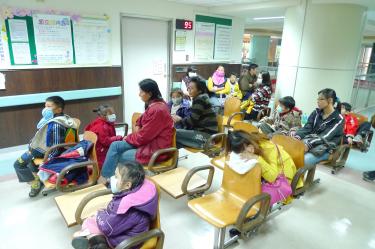It is easier for children to get sick in the spring due to highly unpredictable weather and temperatures as well as children’s lower resistance to infection. Chang Tao-tse, a pediatrician at Miaoli County’s Da Chien General Hospital, says there have been many cases of colds, bronchitis, mycoplasma pneumonia, and croup recently. He reminds parents to pay more attention when a child is not feeling well and to seek immediate medical attention.
Chang says that the common cold is the most frequently seen illness among children in the springtime. Usually a cold passes simply by drinking more water and resting, but if a high fever persists there is the possibility that it will bring about tympanitis or sinusitis. Parents and teachers should teach children to wash their hands often, avoid visiting public places, and wear masks if they do have a cold so that the virus does not continue to spread.
Also common in the spring is bronchitis, the initial symptoms of which resemble the common cold — coughing and a runny nose, but usually the patient recovers in one to two weeks. High fevers and labored breathing occur in serious cases, possibly leading to hypoxia, which requires hospitalization and is a situation that must be taken very seriously.
Chang says that mycoplasma pneumonia is often seen in school-aged children. Its initial symptoms include headaches, fever, sore throat, and lethargy. After two to five days, coughing begins, and sometimes non-respiratory symptoms such as vomiting, abdominal pains, conjunctivitis, and skin rashes also appear.
Croup occurs when a child’s voice suddenly becomes hoarse, with a “barking” cough, stridor, and breathing difficulties, during which time parents usually do not know what to do. Chang says the symptoms of croup usually appear late at night or early in the morning. Breathing warm steam can mitigate the symptoms, but it must not be taken lightly in cases of epilottitis, high fevers, short-temperedness or difficulty swallowing, or if it leads to an acute obstruction of the airways.
Other illnesses that are frequently seen in the spring include chicken pox, enterogastritis, allergic rhinitis, atopic dermatitis, and enteroviruses. Some viruses are picked up at school, so teachers must also help in protecting children’s health by letting parents know when a child is not feeling well and arranging for them to see a doctor.
(Liberty Times, Translated by Kyle Jeffcoat)
春天氣候多變、乍暖還寒,兒童的抵抗力比較弱,因此容易生病,苗栗大千綜合醫院小兒科醫師張濤澤表示,最近常見的有感冒、支氣管炎、黴漿性肺炎與哮吼等,請家長多留意,發現孩子身體不適應趕快就醫。
張濤澤指出,感冒是兒童在春季最常見的流行疾病,一般感冒只需多喝水、多休息,但如果高燒不退,有可能併發中耳炎、鼻竇炎等,家長、老師應教導小朋友勤洗手,避免出入公共場所,如果感冒應戴上口罩,以免擴大傳染。
支氣管炎也好發於春天,初期症狀像感冒,有咳嗽、流鼻水,大多數一到二週可痊癒,但病情嚴重時會合併高燒與嚴重的呼吸窘迫、甚至缺氧,必須住院治療,不可不慎。
他表示,黴漿性肺炎常見於學齡期的兒童,初期症狀包括頭痛、發燒、喉嚨痛、全身無力,二到五天後出現咳嗽,有時也會有嘔吐、腹痛、結膜炎與皮膚疹等非呼吸道方面的症狀。
哮吼是指幼兒突然聲音沙啞、咳嗽像狗吠聲,吸氣有喘鳴聲及呼吸困難,常讓家長們不知所措。張濤澤說,哮吼常發生在夜間和清晨,吸入濕熱的蒸氣可減輕症狀,但如果併發細菌性會厭炎,會出現高燒、煩躁、吞嚥困難,甚至持續惡化阻塞氣道,不能大意。
兒童在春季的常見疾病還包括水痘、腸胃炎、過敏性鼻炎、異位性皮膚炎、腸病毒等,有些疾病是在學校被同學感染造成,因此小朋友的健康也需要老師協助守護,發現學童身體不適應立即家長反映,安排就診。 (自由時報記者傅潮標)
TODAY’S WORDS 今日單字
1. pediatrician n.
小兒科醫師 (xiao3 er2 ke1 yi1 shi1)
例: Your child should see a pediatrician instead of a family doctor if they have a complex medical issue.
(如果你的孩子有比較複雜的醫療問題,應該看小兒科醫師不是家庭醫師。)
2. hoarse adj.
沙啞的 (sha1 ya3 de5)
例: The coach’s voice was very hoarse after yelling at the players during the game.
(教練因為比賽時對球員喊叫,聲音變沙啞。)
3. chicken pox n. phr.
水痘 (shui3 dou4)
例: Chicken pox usually occurs during childhood and is highly contagious.
(水痘通常好發於孩童時期,且傳染性頗高。)
Resources:
http://www.indiaparenting.com/alternative-healing/12_4039/yoga-for-improving-immunity.htmlhttp://www.ndtv.com/video/player/yogasutra/yoga-to-build-immunity/214995

No comments:
Post a Comment